At 5:13 in the morning, anything is possible (except, perhaps, finding an open breakfast spot). That's probably why I imagined myself standing on top of Mt. Superior this morning when I woke up. The flight here yesterday had been uneventful (and catastrophically boring), but now it was time to get up and get moving for the climb.
After a wildly unsatisfactory McDonald's stop (and a 7-11 run, where I found The Holy Grail Of Hostess Products, I pulled into the Park N' Ride parking lot at the mouth of Big Cottonwood Canyon, where I was to meet up with Tyson Bradley--our guide from Utah Mountain Adventures--and Norm, my fellow climber for this trip. We ran over a few details about the climb, piled into Tyson's car, and set out for Little Cottonwood Canyon a few miles south.
The roads were in good shape, and we had no difficulty getting to the base of the route, where we checked snow conditions with our feet to determine whether we needed to bring the extra weight and bulk of the "slowshoes". We had some discussion of the expected weather, and Tyson solicited the thoughts of the climbing party on which route to take. The original plan, of course, was to go up the more technical south ridge as a mixed snow and rock climb; then walk off the summit down the more gentle east ridge, heading toward Alta before glissading down one of the south face snowfields on what he thought would likely be stable snow.
The dilemma was threefold: Do we do the south ridge as planned, with the winds on the mountain predicted to be high, and a storm front moving in? Or do we choose the east ridge as our ascent route to give ourselves a better chance of summiting in what was shaping up to be bad weather? Or do we wait until after the storm tomorrow and try again?
Waiting would have been a good option, but with heavy snowfall in Saturday night's forecast, the whole area would become one great big avalanche hazard. Ultimately, we decided to attempt the original plan, and decided in advance we'd turn back if it got just too sketchy high on the mountain.
We parked the car, piled out, and threw on our packs. Mine weighed in at around 30-ish lbs... probably (once again) too heavy, but experiences like this are all part of working on my methods for paring the weight down.
It's weird... It's sort of somewhere between an art and a science, knowing how much crap to take with you in your pack. The decisions for me to take some of the extras often come down to those items that might help me cope in a wider variety of scenarios, but I'm finding that usually, that extra stuff isn't worth carrying. The reason is that under most circumstances, you'll never need it, and the idea is to plan your trips and act in a way that helps ensure you wont... meaning climbing safely.
I'm a safety boy, and my Boy Scout dad taught me well to be prepared... so from that perspective, it's sorta tough for me to leave those things behind sometimes... and I almost ALWAYS either overpack or underpack on food, which is kinda weird, too. But I'm doing better. (Plus, it's helping to have Foraker on my list as a goal to start keeping my pack weights as lean as possible. Alaska is much less forgiving... and it's a great lesson for any outdoor activity that involves carrying crap on your back, too.)
ANYWAY... with our hardshells and an extra insulating layer underneath our packs, we were prepared for what was forecast to be some potentially wicked weather up on the mountain. Snowshoes reluctantly in hand, we tromped up the road about a quarter mile to the base of the route, which begins at the bottom of an avalanche runout zone from high off Mt. Superior.
Side note: Apparently, avalanches from Superior run out far enough down the lower apron of the mountain (and beyond) every year to completely block the road, which is why they built a second bypass road that splits off from the main road and goes to the other side of the canyon. When the mountain avalanches the main road, traffic just gets redirected. Interesting.
We crossed the main road northward, and talked as the wind started to kick up. We strapped on our snowshoes and began picking our way through the gaps in a broad swath of bushes that protected the base of the mountain, and headed up the broad, rolling apron, aiming left toward a large triangular outcropping of rock.
The wind seemed to be aware of our presence, and it howled its raging disapproval, periodically throwing huge, swirling clouds of airborne ice at our backs, and stinging our faces with needlepoints of pain and cold.
The gusts were so sometimes so strong that the best we could do was turn our back to it, hide inside our hoods, cover our faces with globed hands, and crouch or kneel to lower our center of gravity to prevent us from being swept completely off balance. Up over the apron we went, with the wind finding any patch of exposed flesh, the tiniest clothing gap, and occasionally punishing me for looking back over my shoulder at just the wrong moment for Norm, as if delivering a swift retribution for daring to lift my head.
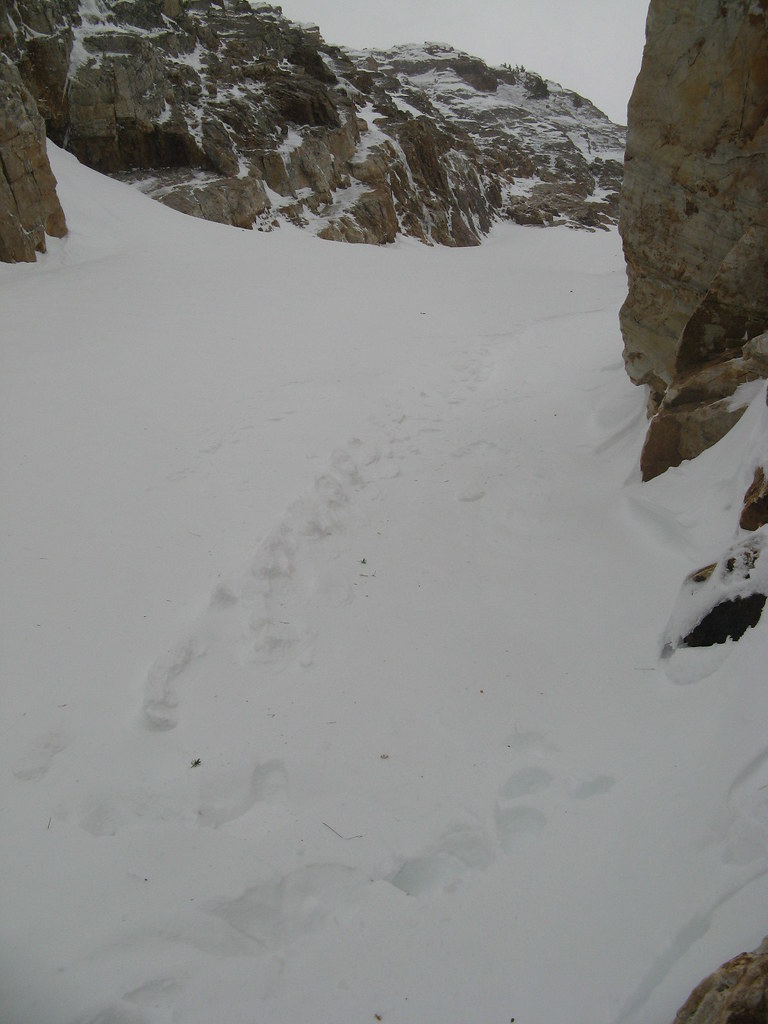 At the outcrop, we did a quick transition from snowshoes to crampons and continued up through the entrance to a steep, narrow couloir--the Suicide Chute, it's called. The entrance to the chute is guarded by huge standing angular rocks--like hungry lions guarding the entrance to a sacred place.
At the outcrop, we did a quick transition from snowshoes to crampons and continued up through the entrance to a steep, narrow couloir--the Suicide Chute, it's called. The entrance to the chute is guarded by huge standing angular rocks--like hungry lions guarding the entrance to a sacred place. The wind continued to worsen as we climbed, accelerating in ferocity, no doubt exacerbated by the presence of the steep, confined rock walls of the chute within which we climbed upward. As the wind came in from the east, it hit the mountain, and swirled violently in angry eddies upward through the lower portions of the chute, pummeling us with gale force.
And every time it came, it pelted us with massive swarms of BB-sized, sugary ice and snow crystals, flung at us with all its might as it blew up the hill. (The noise of this inside a hardshell hood is really loud! Hahaha)
When possible, I would try to take advantage of Mother Nature's wrath, using her gigantic uphill gusts to propel me straight up the fall line in quick climbing spurts instead of the energy-saving traverses most often used. She literally pushed me up the steep slope in places—fun.
The path up the center of this narrow canyon rose sharply above us in a dramatic left-bearing direction around the huge rock buttress created by the south ridge, and as I clambered up over a few patches of rock and ice, my spikes thudded and squeaked as they bit in for purchase.
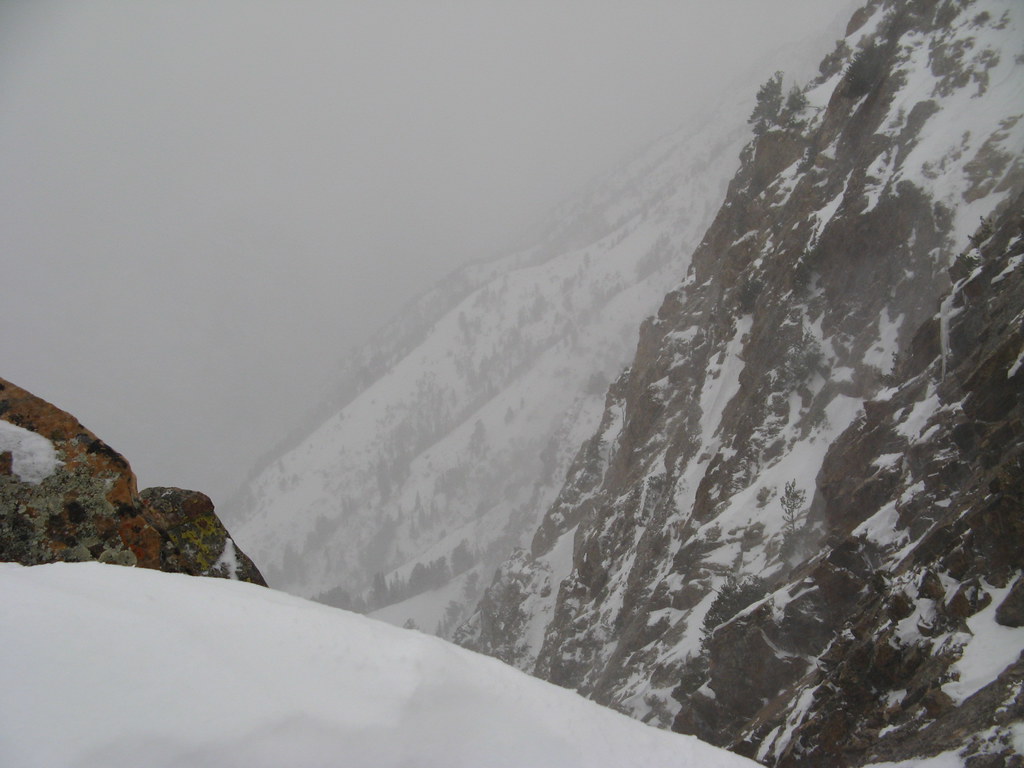 We continued upward, thinking we'd eventually get into a protected area away from the wind for more stable climbing, and after a break, that's exactly what happened. We walked around a huge corner of rock and stepped into complete calm— a windless, serene, and almost ethereal space in this dramatic snakelike couloir.
We continued upward, thinking we'd eventually get into a protected area away from the wind for more stable climbing, and after a break, that's exactly what happened. We walked around a huge corner of rock and stepped into complete calm— a windless, serene, and almost ethereal space in this dramatic snakelike couloir.As a dull gunmetal dawn broke around us, we could hear the now-feckless wind screaming its anger below us, as though it had lost its favorite toy (us) somewhere in the fray--and it wasn't happy about it. Frantically, angrily it hunted us, but to no avail.
The calm that enveloped us was a welcome break that allowed us to do some focused snow climbing, broken only by areas of near- fruitless struggling through thigh-deep sugar-snow that ran like sand around our feet. As we flailed one step back for every two forward, the mini avalanche rivulets we created ran between our legs and ankles, down the slopes below, as new spindrift poured off the couloir walls above our heads to replace it.
Far above us, the col on the south ridge slowly came into view, and we decided to take our next break in the still-protected section just below it. Once there, we stomped out a small platform, got into harnesses, and roped up for the next section of climbing, which was now transitioning to a steep rock ridgeline.
The wind now blasting over the col above our heads was a completely different animal than the seemingly sentient, salivating, screaming-adolescent banshee of a creature we'd encountered below. Above the calm of our canyon, this animal made a vast, booming sound, a growling, freight-train-like low-frequency roar that blasted an ancient and unrelenting rage against anything unfortunate enough to be on that ridge with it.
We discussed our next steps, and decided it was at least worth a look up there to see just how bad it was—even if it was overly optimistic—so with Tyson leading our rope team, me seconding, and Norm behind, we ascended up and out of our quiet little chute and into the maelstrom.
The sound of it was deafening, and utterly unlike anything I've ever heard before. It battered us and ripped all spoken communications from our throats, hurling them to their wordy deaths down the steep, jagged face of rock and ice on the west face far below.
The plan was that Tyson would set up a series of running belays: he'd place the protection in cracks and around protruding points of rock, and then clip the rope he was trailing through it. He'd then climb until I reached it in the middle of the rope at my harness, and then wait until I'd clipped around it before continuing.
So immediately off the col, we turned sharply right and began climbing a steep right-slanting series of cracks and ledges. About halfway up this section, the wind finally began to drill through my warmer gloves, and my hands and fingertips began to get very cold indeed. A quick bout of arm-swinging cured that problem, however, and I continued—up and to the right, baby… up and to the right.
I, as the second of our three man rope team would clip around the placements as I came to them, first clipping the back strand of rope before unclipping the forward strand from my link to the protection Tyson had placed above. And Norm, a rock climber with limited leading experience, brought up the rear as he removed and collected the anchor hardware.
 The immediacy and angle of the rock ascent straight out of the chute took me a little bit by surprise, but I soon had the cautious hang of it, and I got a better feel for what I was doing quickly. That said, footholds and handholds in gloves, crampons and several insulating layers plus a weighted pack are quite a different matter than rock slippers on a sunny, warm day in shorts at the crag.
The immediacy and angle of the rock ascent straight out of the chute took me a little bit by surprise, but I soon had the cautious hang of it, and I got a better feel for what I was doing quickly. That said, footholds and handholds in gloves, crampons and several insulating layers plus a weighted pack are quite a different matter than rock slippers on a sunny, warm day in shorts at the crag. Neverthess, it was clear that I need and would benefit greatly from more exposure to this kind of climbing in addition to time on the crags. Learning to be a little more efficient in my movements will be a key element of my success in the mountains, I think.
Certainly, the sensation of "airyness" as put forth in the climb description—that sense of very steep cliff walls falling away into thin air with long drops beneath your feet, the feeling that a slip might result in a midair dangler—was quite accurate. And though we'd not yet even ascended to the point on that knife-edge ridge where we were under hazard of the most significant exposure along this route, it was an exhilarating feeling to be there… really DOING it.
Once through the first rock portion, we stepped and climbed around a jutting corner of rock that took us out onto a short, steep slabby section of less featured stone that dropped sharply down and to the right into another steep couloir below—with far fewer good holds for hands and feet on it.
I was able to use the frontpoints of my crampons fairly well through this section, however, by jabbing them into stable cracks between solid pieces of stone. Tyson was waiting at the top and providing some feedback on the moves (and a belay), so that was helpful, and I got across it without too much trouble.
Once across, I stepped back onto the steep snow slope that led up to Tyson's position above, and up I went. As I waited for Norm to come up behind, I checked the altimeter: 10,242 feet: 800-ish vertical feet below the summit.
At Tyson's lofty perch on a ledge of the rocky ridge we'd just climbed, he called a pow wow to discuss whether we should continue. Tyson knows this route well and understands what's to come, so he laid it out for us, along with his recommendations. That the forecast for high winds was "verifying" was an inescapable reality. And based on his thoughts, the question of whether we should continue seemed only to be a question in the academic sense at this point. Nevertheless, it was a good discussion.
In our guts, Norm and I, I think, already knew the answer: time to turn back—unacceptable risk ahead. Tyson agreed. Furthermore, in his much more objective and expert opinion, retreat from the point at which we stood becomes increasingly more difficult should the wind outmatch us higher on the mountain. There was also the fact that in the face of 60 MPH gusting winds where we were, rock climbing crux moves of 5.6 at higher elevations become a lot tougher than 5.6.
More important, however, was his concern that should one of us be hit by such a gust in the middle of a delicate rock move in one of the exposed sections of ridge above us, the situation could become an epic in a hurry. None of us wanted that, so he suggested our summit dreams were likely dead. Though disappointing, Norm and I agreed and sounded the retreat.
But even unsuccessful, the ascent was not for naught. Tyson transferred part of his rack to Norm, who led on the way back down. Norm got some practice placing protection, and Tyson evaluated his placements as he removed them on his way down and gave Norm feedback on their quality.
The downclimbing was fun, and I was able to move a little faster this time, just because I'd grown a little more accustomed to the activity. Focus still paramount, we moved back down off the small sideways slabby rock section, back around the rock corner, downward and leftward into the lofty vertical-ish ledgy stuff, dropped back onto the narrow col above the Suicide Chute, and descended back into… a deafening calm of windless peace once more.
As the brash and bellowing freight train wind above us thundered its baritone discontent and lashed the trees on the ridge, Tyson conducted a mini clinic on placing protection with active cams and nuts, and Norm set up an equalized 3-point anchor system for practice.
We all munched some food, had some water, unroped, and began the glissade down the chute, back into the waiting jaws of other reproachful, more high-toned winds far below.
With relatively stable snow conditions today and some avalanche education from Tyson (but keeping a mindful eye on the possibility of avalanche in the chute), we lost altitude quickly with a combination of buttslides and plunge steps. We treated this descent as a backcountry ski descent: one at a time, waiting in avalanche-safe areas below and leapfrogging each other as we went.
The flying torrents of spindrift became so ferocious near the bottom of the chute that my glasses completely froze up at one point and a tiny patch of exposed skin on my forehead between my hat and glasses began to ache from the violent and repeated ice crystal sandblasts.
For a minute or two, I could see nothing of one glissade stretch. Luckily, I was in the middle of a pretty straightforward and controlled slide when it happened, so no harm done. We all switched to goggles just before the couloir spat us back out onto the upper apron once more. It seemed to me as though the rock sentinels guarding the entrance to the Suicide Chute glared at us as we passed between them, bludgeoning our way through thigh-deep posthole snow.
Eventually, Norm and Tyson go frustrated with the hard work of breaking through the crusty snow and switched back to snowshoes, but I figured by the time I got mine on, I could be nearly halfway back to the road if I really kicked it in the ass. And, I reasoned, I could burn a lot more calories struggling in the snow than floating over it, thus making up for some of the lost effort we'd missed out on by not finishing the last 800-1000 vertical feet of climb to the summit.
Ordinarily, I'd never do that, simply because struggling in the snow is a huge energy sink, but once on descent of the upper apron out of the col, a safe return was pretty much assured, so I worked hard on purpose :-) It was fun!
Discomfort is a way of life in the high mountains, and disappointment is sometimes not far behind, so I'd say I learned many valuable lessons today, both physical and mental. And though I am indeed disappointed that I failed on Mt. Superior (this time), it helps me understand more about myself and how I'll handle that disappointment on larger objectives. It's certainly a good possibility on Foraker, a mountain with a mere 30% summit success rate.
But I'll be back another day for another attempt on Madame Superior. The prospects of going to the top by that route are exciting indeed, and I've only just had a taste.

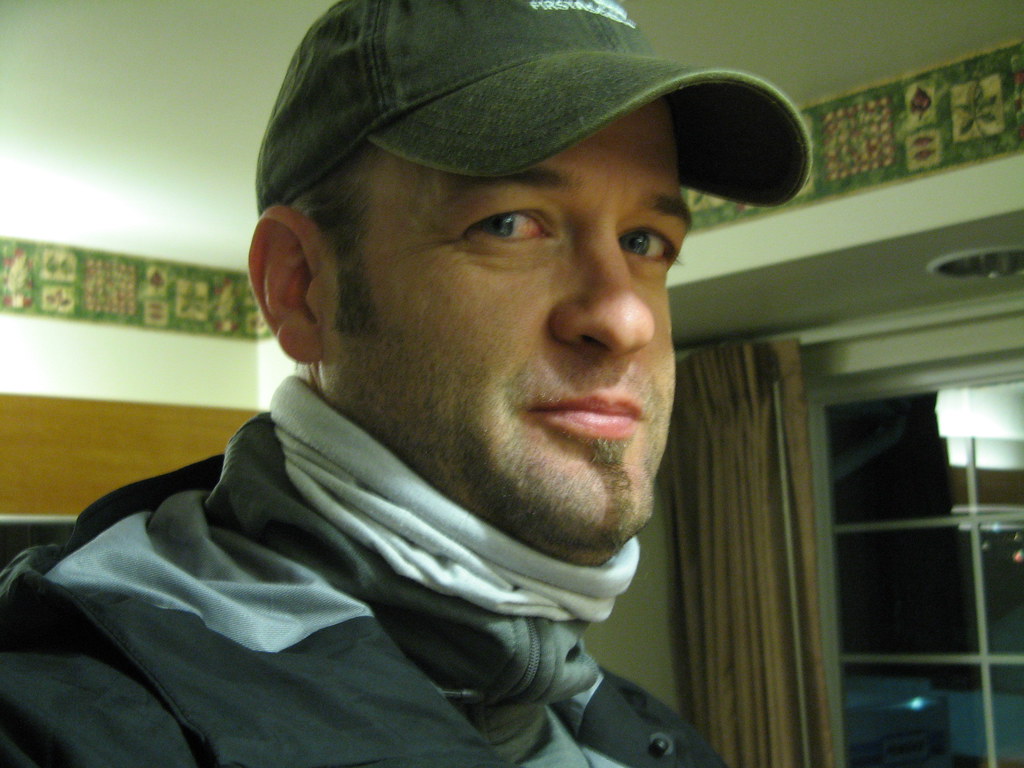
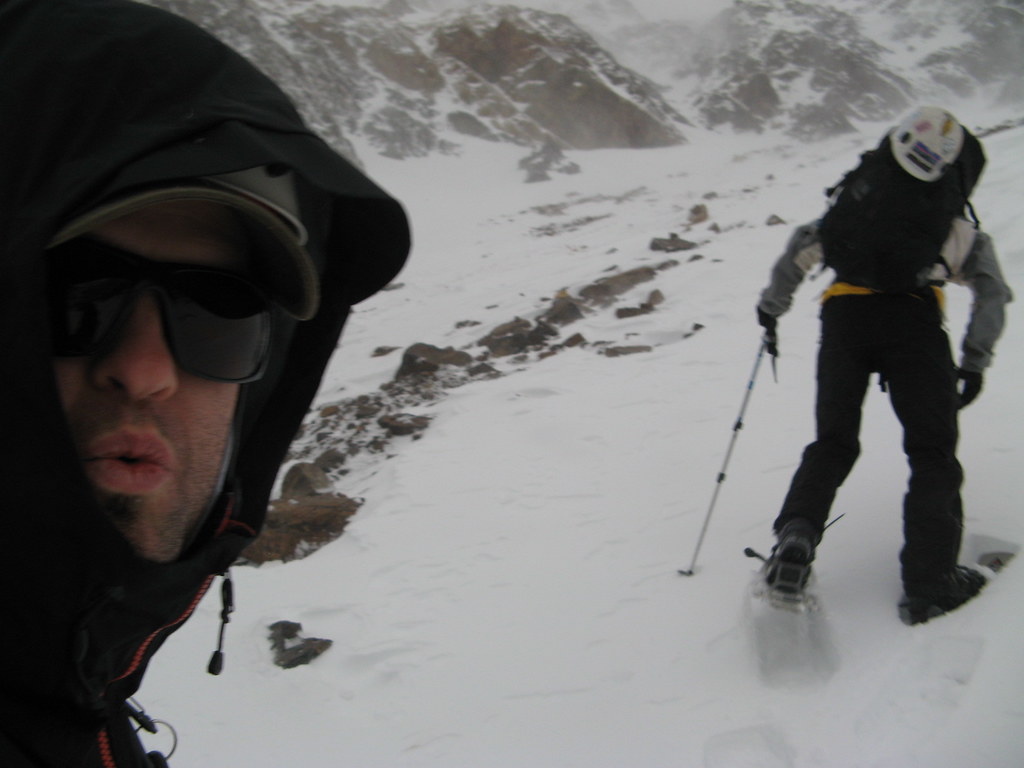

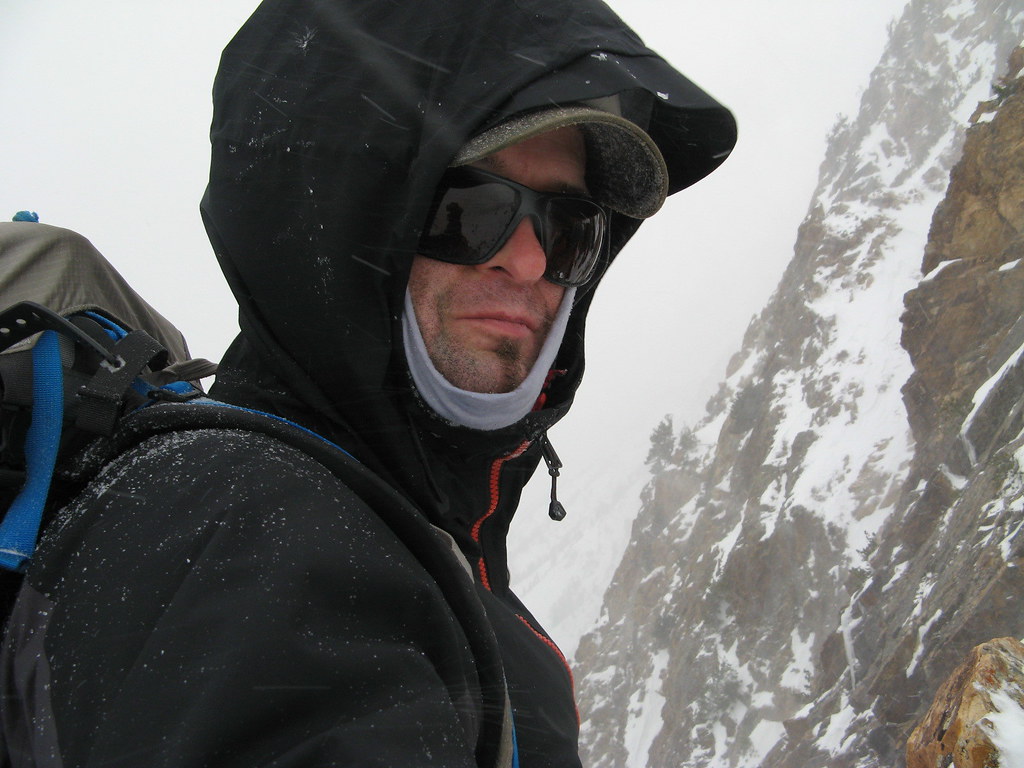

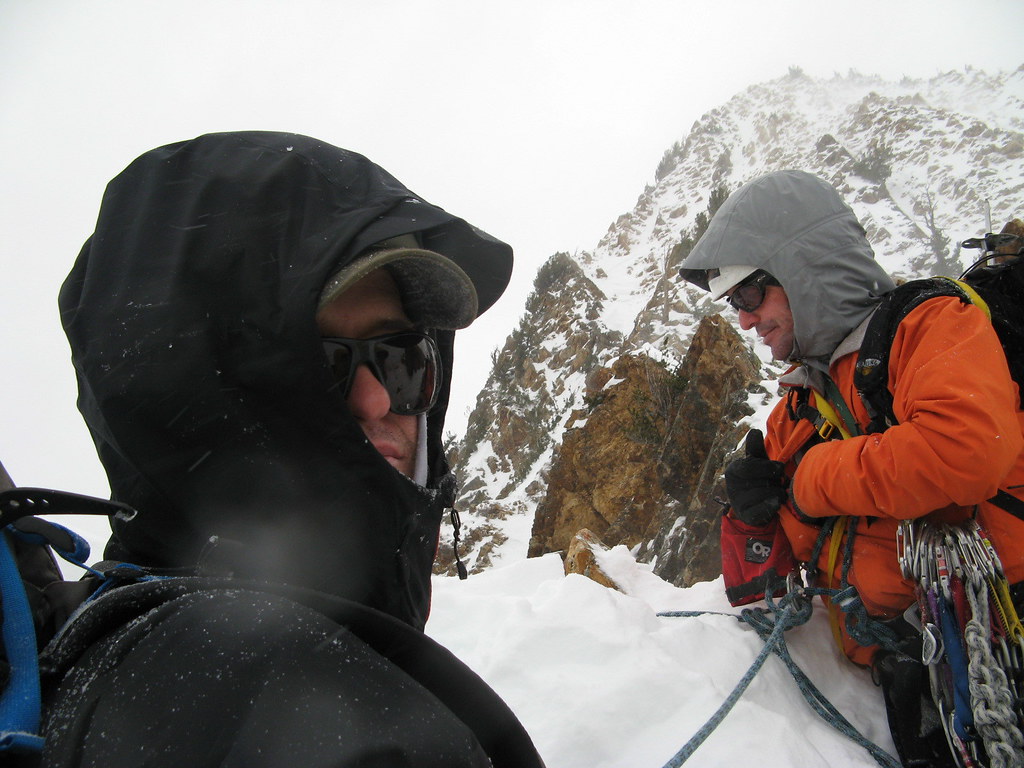

Bry - those pics and videos are magnificent! Utah is amazing, and you're seeing it from a very rare perspective. Thanks for the post.
ReplyDeleteAmazing pics and videos along with a compelling read. While mountaineering will always be a vicarious adventure for me, your descriptions made me feel the ice on my face (a la Jupiter Bowl in -27 degrees--I'm sure Greg remembers as well).
ReplyDeleteAwesome... thanks for the notes :-)
ReplyDelete